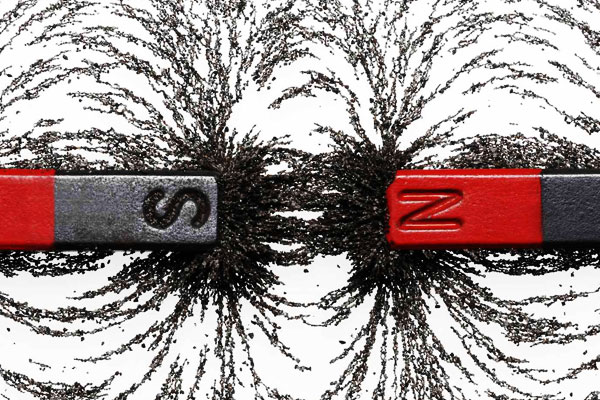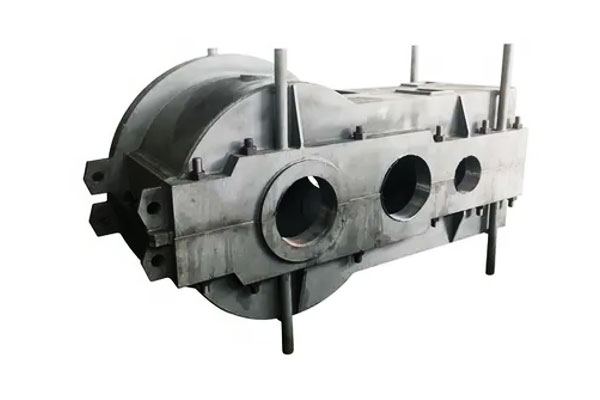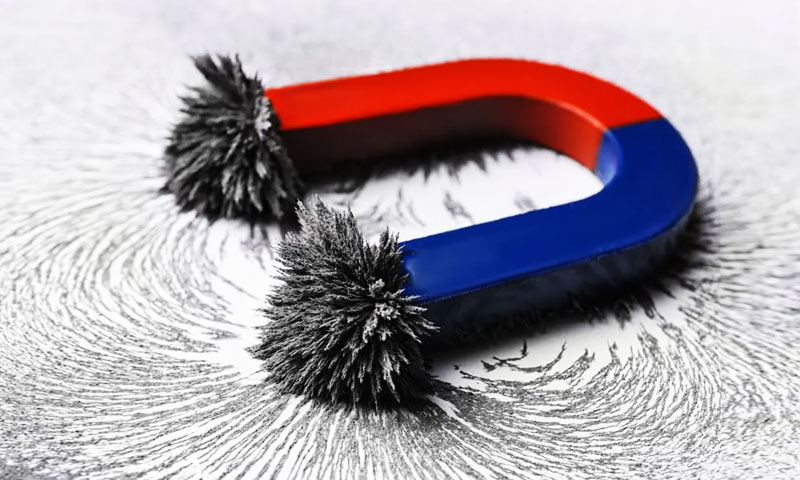1. Introduction
Gray (grey) cast iron is a ferromagnetic engineering material whose magnetic behaviour is set by the iron matrix (ferrite/pearlite/cementite), graphite-flake morphology and processing history.
Those microstructural features control permeability, coercivity, saturation and losses — parameters that matter for magnetic particle inspection, magnetic shielding, proximity to motors/generators and eddy-current behaviour.
This guide explains the physics, gives practical measurement guidance, presents typical numerical ranges for common microstructures, and shows how to design and test castings when magnetic performance matters.
2. Basic magnetism in ferrous materials
Ferromagnetism in iron-based materials arises from aligned magnetic moments (unpaired electrons) in Fe atoms.
Under an applied field H, domains align producing magnetic flux density B. The B–H relationship is nonlinear and shows hysteresis.

A few essential concepts:
- B (magnetic flux density) and H (magnetizing field) are related by the nonlinear B–H curve.
- Relative permeability (μr) measures how much easier a material is to magnetize than vacuum (μr = B/(μ0H)).
- Coercivity (Hc) is the reverse field needed to reduce B to zero after magnetization (a measure of how “hard” the magnetization is to remove).
- Remanence (Br) is the residual flux density when H returns to zero.
- Saturation flux density (Bs) is the maximum B the material can sustain (limited by ferromagnetic volume fraction).
- Curie temperature (Tc) is the temperature above which ferromagnetism disappears (for iron phases around ~770 °C, modified slightly by alloying).
Gray cast iron behaves as a soft ferromagnet at room temperature (low coercivity relative to permanent magnets), but with permeability and hysteresis losses that depend heavily on microstructure.
3. What controls magnetism in gray cast iron?
Gray cast iron comprises graphite flakes embedded in an iron matrix (ferrite and/or pearlite and sometimes cementite). Each constituent affects magnetism:
- Ferrite (α-Fe) — body-centred cubic iron. Soft ferromagnetic; contributes higher permeability and low coercivity.
- Pearlite (mixture of ferrite and cementite Fe₃C) — pearlitic regions contain ferrite lamellae interleaved with cementite;
these reduce effective permeability and increase coercivity compared with pure ferrite because cementite is non-ferromagnetic (or weakly magnetic) and creates domain pinning. - Cementite (Fe₃C) — not strongly ferromagnetic; acts as a magnetic diluent and domain wall pinning site.
- Graphite flakes — electrically and structurally discontinuous inclusions. Graphite itself is not ferromagnetic; flakes interrupt magnetic continuity and create local stress concentrations and internal demagnetizing fields.
The net result is a reduction in effective permeability and increased hysteresis losses relative to a fully ferritic matrix.
Therefore: more ferrite → higher μr, lower coercivity; more pearlite/cementite → lower μr, higher coercivity and hysteresis loss.
Graphite morphology (size, orientation, volume fraction) controls anisotropy and scattering of magnetic flux.
4. Key magnetic parameters and how they are measured
- B–H curve / hysteresis loop — measured with a permeameter or Epstein frame (for lamination steels) and gives μr(H), Hc, Br, and Bs.
- Relative permeability, μr (initial and maximum) — initial μr at small H (dictates small-signal response) and maximum μr at moderate fields.
- Coercivity Hc (A/m or Oe) and remanent flux density Br (T) — indicate how “soft” or “hard” the magnetic behaviour is.
Gray iron is a soft ferromagnet (low Hc) relative to permanent-magnet materials but typically harder than annealed low-carbon steels if pearlite/cementite content is high. - Saturation flux density Bs (T) — measured at high H; gray iron’s Bs is lower than pure iron because of non-magnetic phases and porosity.
- Curie temperature Tc — for iron phases ~770 °C; alloys and microstructure shift Tc slightly; measured with thermomagnetic analysis.
Typical measurement tools:
- Portable permeability meters for quick shop checks.
- Vibrating sample magnetometer (VSM) and hysteresisgraph for laboratory B–H loops.
- Eddy-current probes and impedance analysers for frequency-dependent permeability and loss.
5. Magnetic Properties of Typical Gray Cast Iron Grades
Below is a compact, engineering-focused data table showing representative magnetic property ranges for common grey-iron microstructures and for three commonly specified grades.
Because cast iron magnetics are strongly process-dependent these figures are ranges intended for preliminary design — for magnetically critical parts request B–H loops on representative coupons.
| Grade / Microstructure | Typical microstructure (graphite : matrix) | Initial μr (approx.) | Maximum μr (approx.) | Coercivity Hc (approx.) | Saturation Bs (approx.) | Electrical resistivity (relative) | Typical implications |
| Ferritic gray iron (high-ferrite) | Flake graphite (~2–4% vol) in largely ferritic matrix | 200 – 1 000 | 1 000 – 2 500 | 50 – 200 A/m (≈0.6–2.5 Oe) | 1.30 – 1.70 T | ~2 – 4× mild steel | Highest permeability / lowest hysteresis loss of grey irons; best for MPI sensitivity and low-loss static flux paths |
| EN-GJL-200 (softer, more ferrite) | Flake graphite, ferrite-rich matrix | 150 – 600 | 600 – 1 500 | 80 – 300 A/m (≈1.0–3.8 Oe) | 1.20 – 1.60 T | ~2 – 4× mild steel | Easy to magnetize; suited for housings where some magnetic pathing or MPI is required |
| EN-GJL-250 (typical commercial mix) | Flake graphite, mixed ferrite/pearlite matrix | 50 – 300 | 300 – 1 000 | 200 – 800 A/m (≈2.5–10 Oe) | 1.00 – 1.50 T | ~2 – 5× mild steel | Moderate permeability; properties sensitive to pearlite fraction and graphite morphology (common engineering grade) |
| EN-GJL-300 (higher strength; more pearlite) | Flake graphite, pearlite-rich matrix | 20 – 150 | 150 – 600 | 400 – 1 500 A/m (≈5.0–19 Oe) | 0.80 – 1.30 T | ~3 – 6× mild steel | Lower μr and higher hysteresis loss; requires larger magnetizing MMF for MPI or fluxing |
| Chilled / heavily pearlitic / cementitic | Fine graphite/white-iron chill regions, high cementite | 10 – 80 | 80 – 300 | 800 – 3 000 A/m (≈10–38 Oe) | 0.7 – 1.2 T | ~3 – 8× mild steel | Lowest permeability, highest coercivity/hysteresis; poor for magnetic circuits, often highest remanence after magnetization |
How to read and use this table (practical guidance)
- Initial μr is the small-signal permeability — relevant for sensors, small DC fields and the first magnetization step in NDT.
- Maximum μr indicates how readily the material will concentrate flux before approaching saturation — important when predicting leakage paths or shunting.
- Coercivity (Hc) shows how “hard” the material is to demagnetize after being magnetized (higher Hc → more remanent field after MPI). Convert A/m → Oe by dividing by ≈79.577 (e.g., 800 A/m ≈ 10.05 Oe).
- Saturation Bs is the practical upper limit for flux density; gray iron’s Bs is lower than that of pure iron and many steels because non-magnetic graphite and cementite reduce the ferromagnetic volume fraction.
- Relative resistivity is given as a multiple of mild steel resistivity (qualitative).
Higher resistivity reduces eddy currents at AC frequencies — an advantage for rotating machinery housings or where eddy losses could be an issue.
6. How chemistry, microstructure and processing change magnetic properties

Alloying:
- Carbon content & graphitization: higher free carbon → more graphite → reduced μr and Bs.
- Silicon promotes graphitization and increases resistivity; moderate Si tends to reduce permeability vs pure iron.
- Sulfur, phosphorus and other trace elements affect graphite morphology and thus magnetic continuity.
- Alloying elements like Ni, Cr, Mn change magnetic exchange interactions and can lower Curie temperature or modify coercivity.
Heat treatment:
- Annealing (ferritizing) increases ferrite fraction, increases μr and reduces coercivity (softens the magnetic response).
- Normalizing / faster cooling increases pearlite/cementite → reduces μr and increases Hc.
- Localized heating or welding can create magnetic inhomogeneity and residual stress, which changes local permeability and can be detected nondestructively.
Mechanical deformation:
- Cold working introduces dislocations and residual stress → domain wall pinning raises coercivity and lowers permeability. Stress relief reduces these effects.
Porosity & inclusions:
- Pores and non-magnetic inclusions interrupt flux paths and lower effective μr and Bs. They also can increase hysteresis and loss.
7. Anisotropy and graphite-flake effects — why casting orientation matters
Graphite flakes tend to orient perpendicular to heat flow during solidification, often aligning roughly parallel to mould surfaces. The flakes produce magnetic anisotropy:
- Flux traveling parallel to flakes encounters different demagnetizing fields than flux crossing flakes perpendicular to their plane.
- Thus measured μr and permeability spectra can be direction dependent; in practice this means magnetic circuits using castings should consider orientation — e.g., aligning flux paths to traverse the more permeable direction where possible.
Graphite flakes also create local strain fields, which further affect domain wall motion and thereby hysteresis behaviour.
8. Electrical resistivity, eddy currents and magnetic losses in gray iron
- Resistivity: Gray cast iron typically has higher electrical resistivity than low-carbon steel because graphite flakes and impurities disrupt electron paths.
Qualitatively: resistivity of gray iron is several× that of typical low-carbon steel. Higher resistivity reduces eddy current magnitude for a given alternating magnetic field. - Eddy-current loss: For AC magnetics, loss = hysteresis loss + eddy-current loss.
Because of higher resistivity and the flake structure, eddy losses in gray iron are often lower than in dense steel of similar permeability, making gray iron comparatively attractive where low to moderate frequency magnetic fields exist and eddy losses matter.
However, graphite flakes can create micro-circuits that complicate loss prediction. - Hysteresis loss: Increased by pearlite/cementite and domain wall pinning; gray iron with high pearlite fraction typically has higher hysteresis loss than ferritic cast iron.
Design implication: for low-frequency magnetic circuits (DC or static), gray iron can carry flux but will not match electrical steel cores for high-efficiency AC magnetic circuits.
For components where magnetic loss is secondary (engine housings near motors, magnetic mounting surfaces), gray iron’s combination of moderate permeability and reduced eddy loss can be acceptable.
9. Practical applications and implications
Magnetic Particle Inspection (MPI)
- Gray iron is magnetizable and widely inspected using MPI for surface and near-surface defects.
The magnetic response (ease of magnetization and required current) depends on permeability—ferritic castings are easier to magnetize than pearlitic ones. Field orientation relative to graphite flakes matters for sensitivity.
Motor & generator housings, frames and enclosures
- Gray iron housings are commonly used for mechanical support near magnetic machines. Their magnetic permeability can cause magnetic shunting or alter stray-field patterns.
Designers must account for magnetic coupling (e.g., induced currents, magnetic leakage) when enclosures are close to active coils or permanent magnets.

EMI / magnetic shielding
- Gray iron can act as a magnetic path or partial shield for low-frequency fields because of its permeability, but specialized soft magnetic alloys or laminated electrical steels are preferred where high shielding effectiveness and low loss are required.
Gray iron’s higher resistivity helps at intermediate frequencies, but lack of controlled permeability and anisotropy limit performance.
Eddy-current testing and EMI coupling
- Increased resistivity is advantageous for reducing eddy currents in AC environments; however, graphite flakes and porosity make detailed prediction of skin effect and eddy distribution complex.
Magnetic sensor location and stray fields
- Engineers using fluxgate, Hall or inductive sensors near castings must consider local magnetic anomalies from inhomogeneous cast iron microstructure and residual stresses.
10. Measurement best practice and NDT considerations
- When to measure: specify permeability or B–H curve for magnetically critical castings (bearing housings in electromagnetic actuators, frames that form part of a magnetic circuit).
- How to measure: small coupons (representative location and orientation) measured in laboratory with a permeameter or VSM;
for shop acceptance, portable permeability meters or ring/collar tests are used.
Report both initial μr and μr at relevant field (e.g., 0.5–1.0 T) plus hysteresis loop if AC losses matter. - For MPI: calibrate magnetization current to the lowest required to reveal defects without stimulating unwanted remanence;
remember that coercivity differences can change retainment of magnetization (affects demagnetization after testing). - Record orientation: always report orientation of test (parallel/perpendicular to casting surface) because anisotropy exists.
11. Common Misconceptions & Clarifications
All Gray Cast Iron Is Highly Magnetic
False. Magnetic strength depends on matrix phase: Ferritic EN-GJL-200 is strongly magnetic (μᵢ = 380 H/m), while pearlitic EN-GJL-300 is moderately magnetic (μᵢ = 220 H/m). Graphite-rich grades (C >3.5%) have weak magnetic response.
Carbon Content Does Not Affect Magnetism
False. Carbon forms non-magnetic graphite—increasing C from 3.0% to 3.8% reduces permeability by 30–40% (critical for high-magnetic applications).
Gray Cast Iron Can Replace Silicon Steel in High-Power Motors
False. Silicon steel has μₘ = 5000–8000 H/m (2–4x higher than gray cast iron) and lower hysteresis loss—gray cast iron is limited to low-to-medium power (≤5 kW) applications.
Heat Treatment Has No Impact on Magnetic Properties
False. Annealing converts pearlite to ferrite, increasing μᵢ by 30–35%—critical for optimizing magnetic performance in post-cast components.
12. Conclusion
Gray cast iron is a magnetic, but microstructure-sensitive material.
Ferritic microstructures give the best permeability and lowest hysteresis loss, while pearlitic/chilled microstructures reduce permeability and increase coercivity and hysteresis.
Graphite flakes introduce anisotropy and locally reduce magnetic continuity but raise electrical resistivity (helpful for limiting eddy currents).
For any magnetically important casting (MPI, proximity to electromagnetic devices, partial shielding) specify and measure magnetic parameters (initial μr, B–H loop, coercivity, orientation) on representative coupons.
When in doubt, ask the foundry for B–H data or conduct simple permeability tests during incoming inspection.
FAQs
Is gray cast iron magnetic?
Yes. It is ferromagnetic at room temperature; however, its permeability and hysteresis depend strongly on matrix (ferrite vs pearlite), graphite content and processing.
Can I use grey iron as a magnetic core material?
Not for high-performance AC cores. Grey iron can carry flux and provide partial shielding at low frequencies, but electrical steels or soft magnetic alloys give much better, predictable performance with lower losses.
How does graphite affect MPI results?
Graphite reduces local permeability and causes anisotropy.
Ferritic regions magnetize easier and show higher MPI sensitivity; pearlitic/chilled areas require stronger magnetization and may trap remanence.
What magnetic data should I request from a supplier?
Request: representative B–H loops (two orientations if possible), initial and maximum μr, coercivity (Hc), saturation Bs and a description of the measured orientation/heat-treatment. Also request metallography photos showing graphite morphology.
How do I reduce remanent magnetization after MPI?
Use controlled AC demagnetization (gradually decreasing alternating field) or apply a DC reverse field slightly higher than remanent field, per NDT standard practice. Verify residual field with a gaussmeter.



